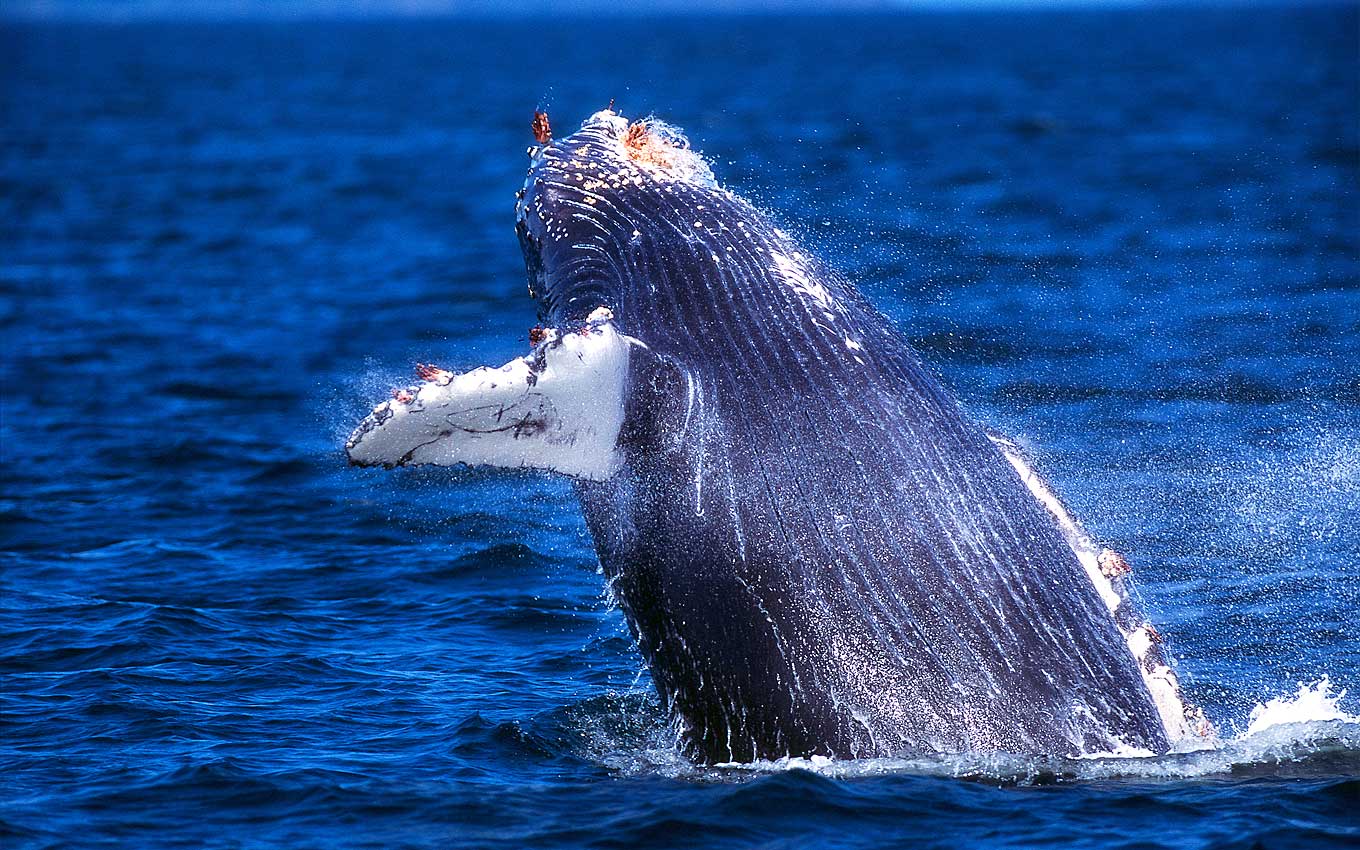
Humpback Whale Behavior Guide
Baleen whales feed by taking in large amounts of both water and food (primarily herring, mackerel, and krill) then straining the water through the baleen plates hanging from their upper jaws. During feeding, ventral pleats running from the lower jaw to the navel allow a whale to expand its mouth up to 4 times its usual size. While in the nutrient-rich waters of Alaska, Humpbacks consume about 1 ton (2,000 lbs.) of fish during a single day!
Behavior
Intelligent Fishing
Humpbacks have developed an ingenious method of cooperative fishing called bubble-net feeding. First, hunting members of a pod form a large circle deep below fish and krill. The whales then blow a cylindrical wall of bubbles as they swim upwards in a spiral path. The bubbles confuse the fish and krill, concentrating them at the surface, and making an easy feast for the whales.
Understanding Whales
Humpbacks have developed an ingenious method of cooperative fishing called bubble-net feeding. First, hunting members of a pod form a large circle deep below fish and krill. The whales then blow a cylindrical wall of bubbles as they swim upwards in a spiral path. The bubbles confuse the fish and krill, concentrating them at the surface, and making an easy feast for the whales.
Blow
The normal pattern of exhalation and inhalation at the surface. If you are close enough you'll be smelling some fishy whale breath!
Fluke Dive (sounding)
Signals a deep dive. Following a peduncle arch, the Humpback will usually bring its flukes high above the surface of the water, propelling it straight down.
Pectoral Slap
The whale rolls to the side, slapping its pectoral fins against the water. Whales will also lie on their backs and slap both pectoral fins on the water.
Spy Hop
The whale rises vertically to a point where the eyes are above water, then spins on it's longitudinal axis to get a look at the surrounding area.
Breach
The whale propels itself out of the water, generally clearing the surface with two-thirds of its body or more, often with a twisting motion. Amazing!
Tail Slap
Forceful slapping of the flukes against the surface of the water. Sounds from tail slaps can be heard for miles.
Peduncle Slap
Aggressive behavior where both the caudal peduncle and flukes are thrown up out of the water and brought down with force, often on top of another whale.
Head Slap
Head-first lunge out of the water, the whale pounds its massive, sometimes partially engorged mouth on the water's surface.
Humpback Whale Migration - An Annual Journey
Each year approximately 4,500 Hawaiian Humpbacks migrate from Alaska to breed, give birth, and bask in the warmer waters of Hawaii.
Kohola begin arriving in Hawaii in November, with the peak of migration and activity occurring in February and March. Scientists speculate that the whales use ocean currents, temperature changes, acoustical cues, and the Earth's magnetic field to find their way to Hawaii (the most remote island chain in the world).
Most whales remain in Hawaii for 6-8 weeks, with some extending their "vacation" to late May or early June. At the end of their time in Hawaii, the whales return to the food-rich waters of Alaska to feed and replenish their blubber in preparation for their next journey to Hawaii.
Whale Social Structure & Communication
Humpback whales generally swim in pods; the basic social group consists of the cow (female), a single calf, and the "escort" male. Most Humpback behaviors seen in the Hawaiian Islands are related to courtship and mating, which places the cow at the center of socialization during the winter months. Escorts do little to help raise the calves because their primary attention is directed to mating and fending off other males.
Mating Competition
When two or more escort males are accompanying a cow, mating competition can become intense. Male Humpbacks have been witnessed using glancing rostrum blows, lateral fluke swipes, bubble streaming, head lunging, and various vocalizations during mating challenges. Scars and gouges are common amongst adult males; some display dorsal fins that have been sheared off during past confrontations. This brutal competition puts serious pressure on cows and their calves, often forcing them to expend great energy avoiding rushes and collisions from challenging escorts. These competitions can range in size from three whales to two dozen and are an amazing sight to witness.
Mood Music or call to Battle
Although female Humpbacks are capable of producing sounds, only the males produce highly structured "songs" which feature distinctive melodies and themes. Scientists have found that all the males in a Humpback population sing the same song at any one time. The song pattern changes over time, but all the males still sing the same new song. The songs can be heard more then 20 miles away and may last up to 20 minutes.
Humpbacks don't have vocal chords; their songs are most likely produced by circulating air through the tubes and chambers of their respiratory system. No air escapes during the concerts and they are almost always performed on breeding grounds. The males usually sing suspended deep below the surface, their long pectoral fins jutting rigidly from their sides. Scientists have documented that the majority of the whales approaching singers were other males. Since the ensuing meetings often end in a competitive tussle, it is now believed the whales are issuing threats rather than singing love songs.


